Switch with motion sensor: how to select and install a light switch with sensor
To simplify their lives and reduce electricity costs, owners often install various automatic light control systems in their homes. One of these electronic devices is a motion sensor switch (MS), which turns on the lighting without human intervention when a person enters the room.
And when there is no one in the room, this device itself turns off the light bulbs. Installing such a device is not difficult, and there are a lot of benefits from it. We will tell you how to choose the right smart device, in what order and where to attach it.
The content of the article:
How does a DD switch work?
A circuit breaker with a non-contact motion sensor means a combined electrical device that responds to the movement of someone in a certain control zone. It is suitable for installation indoors and outdoors. You just need to wisely choose the degree of its IP protection.
This can be either a control unit with only a sensor, or a device supplemented with a key switch. However, in the first case, you won’t be able to turn on the lighting by hand by slamming a button on the wall. This feature of contactless automation should not be forgotten.
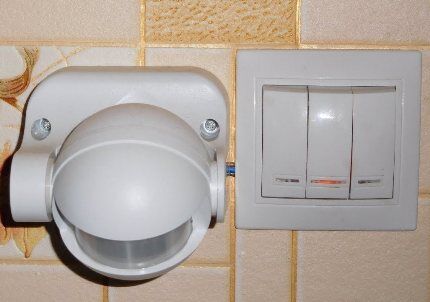
The range of devices under consideration is huge. Electrical stores have options with different types of detectors and different layouts.When choosing such a switch, the most important thing is to decide in advance where it will be installed.
In some cases, a combined model in one case is more suitable, while in others you will have to take several independent devices and connect them together with wires.
The light switch with a motion sensor works as follows:
- when there are no moving objects in the observation area, the device opens the power circuit;
- when a person enters the area, a sensor is triggered, which closes the power supply circuit of the light bulbs;
- as long as someone moves within the range of the sensor, the circuit remains closed;
- after everyone leaves the controlled room (or area on the street), the circuit opens again and the lights are turned off.
In order not to waste electricity during the day, such a switch is often supplemented with a photosensor for controlling the light level. In this case, as long as there is enough sunlight, the device will not operate and turn on the light bulbs.
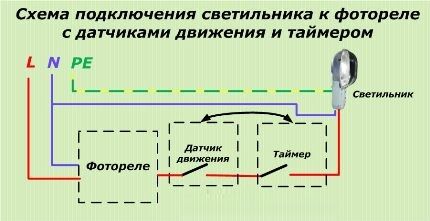
Switches with motion sensors are installed to control light in the following areas:
- on staircases and corridors of apartment buildings;
- in basements, storage rooms and garages, where there is no natural light at all, and the button for a regular switch is difficult to find in the dark;
- in toilets and bathrooms to increase the comfort of using plumbing equipment when you are asleep at night;
- in private cottages built using smart home technology.
Often such a device is part of a security system.In this case, when the alarm is not functioning, the sensor works to turn the lights on/off, and when activated, it monitors the entry of strangers into the protected premises.
Types of motion sensors
To classify devices, we define two main factors: the presence and type of sensor device, as well as installation features.
The main element in the circuit breaker under consideration is a motion sensor. There are several varieties of it, based on different physical laws.
In all cases, the result is the same: when an object appears in the controlled area, the sensor is triggered and the contacts of the circuit supplying the lighting devices are closed.
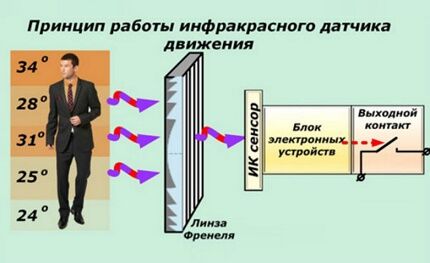
Motion sensors for automatically turning on and off lights are:
- Acoustic.
- Infrared.
- Ultrasonic.
- Microwave.
The first two categories of sensors belong to passive devices; they do not emit anything. The detectors of the two remaining varieties are active devices. These options send waves of various lengths into the room, and by the nature of their reflection they determine the presence or absence of new objects in their coverage area.
Equipment of the “active” class with an emitter and receiver is more expensive than “passive” models. The devices are more complex in design, but have a low level of false alarms. Passive devices in this regard are much inferior to their active counterparts, but are cheaper than their competitors.
Acoustic sensors are triggered by the sounds of doors opening, the clicking of heels, and simply sharp claps.This option is best taken for corridors of public buildings.
It is also ideal as an addition to other sensors, so that the light can be turned on by clapping your hands. It is not recommended to install it alone in a private house. There will be too many false reactions to various sharp sounds.
Infrared sensors are designed to be triggered by human heat. But they also react to animals and heated radiators. They must be carefully configured, and the coverage area must be set so that radiators do not fall into it. This is the simplest, most durable and cheapest touch sensor for automatic light control.
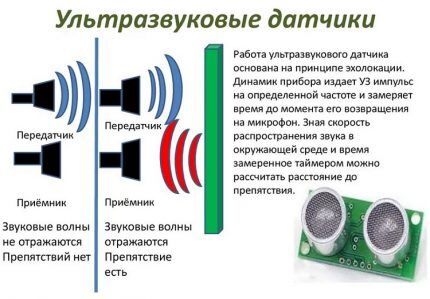
Sensors operating by emitting microwaves and ultrasound are not recommended for installation in residential premises. A person is not able to feel their impact, but it is there, but there is definitely no benefit from it. It has been noticed that domestic animals often react to this radiation in a sharply negative manner.
Such emitters are more suitable for parking lots or open areas. At the same time, active motion sensors also have a limited range.
When organizing control over a large area of ultrasonic devices, you will have to install a lot. Plus, many of them only work during sudden movements. A slowly walking person may completely “fall out” of their field of action.
The ideal option is a combined sensor with several methods of detecting people entering the controlled area. It is more reliable and less likely to trigger erroneously.However, you will have to pay a lot for this accuracy, since such sensors are obviously more expensive than conventional analogs.
Choosing the optimal installation location
If the key switch comes with the sensor in the same housing, then it is designed for wall mounting. However, if the sensors are supplied in a disassembled kit or purchased separately, then they can be installed not only on the wall, but also on the ceiling. Moreover, the ceiling option is often preferable, since it covers a large area.
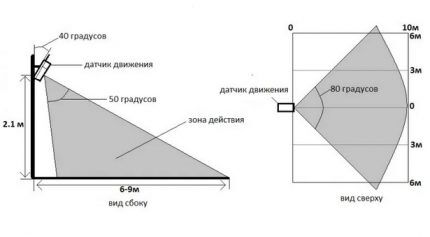
Each sensor device has its own viewing angle ranging from 10 to 360 degrees. If he has this parameter less than 360O, then the sensor will be able to track movements only in a narrow observation sector. In this case, you will have to install several tracking devices in the room so that they cover all the required space.
Wide-angle and circular detectors are more expensive than those designed for a small coverage angle. However, too many of the latter may be required to completely control the room. Here it is important to carefully weigh and calculate everything before going to the store for consumables.
If the switch is placed in a small room with one door, then sensor installation with a narrow viewing sector it will be enough. You just need to point it precisely at the entrance and set the maximum possible time for turning on the light in the settings.
Another point is that the motion detector has a “dead zone” in height. During installation, you must carefully study the passport in order to correctly set the direction of operation of the sensor.
Plus there are still restrictions on the range of the detection zone.For verandas or long corridors, it is recommended to choose long-range devices. However, remember that with a large area of control, they may begin to work too often at the wrong time.
Technical parameters and setup
Most models of light switches with a motion sensor are designed for direct connection of lighting devices to a 220 Volt network. In fact, this is a standard key-based light switch, but supplemented with a detector and an automation board.
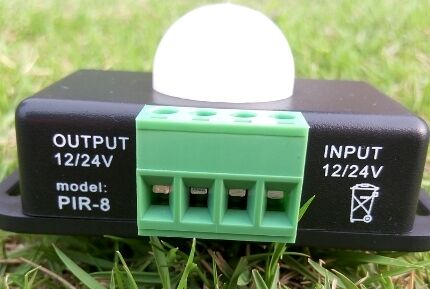
Each model of the switch in question has a parameter indicated in its passport - the maximum connected power. It reflects the total power of connected lamps. If the device is used for a group of lanterns in a fence near a cottage, then this value should be around 1000 W.
Otherwise, it will burn out the first time you turn it on. For installation in the rooms of a private house or apartment, a device for 300–500 W is more than enough.
With rules for connecting a motion sensor to the lighting device it serves read the article, the content of which is devoted to the analysis of this difficult issue.
The degree of protection must be at least IP44. This is quite enough for heated rooms in a cottage. But for installation outdoors or in a bathroom, it is better to take one with IP “55”, “56” or higher.
As a rule, a switch on the body equipped with a motion sensor has three adjustment controls:
- “TIME” – response time to turn off the light after a person leaves the room.
- “LUX” (“DAY_LIGHT”) – sensitivity to illumination (if there is a photo relay).
- “SENSE” – sensitivity to movement (temperature in the case of an infrared sensor).
The first parameter can vary from 0 to 10 minutes. If the narrow sensor is aimed only at the door in the pantry, then it is better to set this adjustment to maximum. Then, when entering the “dead zone,” you won’t have to worry that the light will turn off at the most inopportune time. At the same time, 5–10 minutes is quite enough to take something from a shelf in a closet.
The sensitivity to motion triggering and the degree of illumination are set by trial method. This is affected by the level of insolation, the presence of animals in the house and heating radiators nearby, and even swaying trees nearby. If there are too many false positives, then this parameter should be gradually reduced and brought to optimal values.
Basic installation diagrams
There are several schemes for connecting a switch and an external motion sensor to the power circuit of lighting devices. In general terms: the sensor is inserted into a wire break with a phase. There are three terminals on its body. The corresponding cores of the power cable are connected to “L” and “N”, and from the third terminal the wire is sent to the lamp.

If one automatic detector is not enough and you also need a manual way to turn on the lighting, then the “key” can be connected to the circuit in two ways. In the first, such a switch is inserted into the phase wire going to the sensor from the panel. When it is open, the sensor simply does not work and does not supply voltage to the light bulb.
The second option involves inserting a switch into the line from the phase to the input to the electric lamp.When such a “key” is closed, the light will remain on even if the sensor does not work.
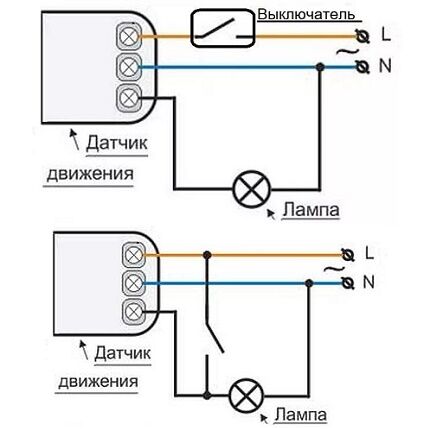
If you need to install several detectors, they are connected to each other in parallel. The power wire goes to the lamp from each of them. Light will appear when any of the sensors is triggered. If this solution seems unnecessarily complicated, it is better to purchase light bulbs with built-in motion sensor.
If the lighting device is powerful or there are several of them, then a magnetic starter with an amplifier should be installed in the circuit instead of a light bulb. And through it, power a separate lighting circuit. In this case, you can choose a low-power and cheaper detector.
Majority energy saving lamps quickly burn out when the voltage is turned on and off frequently. Therefore, connecting them via a motion sensor is not always advisable, since they will fail too often. The resulting savings from using such light bulbs will be zero.
To avoid problems with expensive lamps burning out, after the motion sensor, it is necessary to install a protection unit with soft switching on of the light in front of them. Due to the absence of sudden changes in voltage in the electrical network, light bulbs will not “burn” as often as without such a protective device.
Will familiarize you with the markings and rules for selecting smart switches next article, which we strongly recommend reading.
Conclusions and useful video on the topic
To make it easier for you to understand all the features of choosing and installing the devices in question, we have made a selection of video materials for you. Everything is explained in detail and thoroughly.
Video #1. The nuances of connecting a motion sensor and a standard switch with a key:
Video #2. Overview of sensors for combined automatic lighting switches:
Video #3. Description of connection diagrams:
Automatic “switches” that incorporate a motion sensor are extremely easy to install. At the same time, energy savings from their use are significant. In addition, they make the house more comfortable to live in.
You should not hesitate to install such automatic devices. You can do everything yourself, without the involvement of highly qualified electricians.
Please write comments in the block below, ask questions, post photos on the topic of the article. Tell us about how you chose a smart switch for your own home/apartment/office. Share useful information with site visitors.




A few months ago, my husband decided that he needed to install a motion sensor in the hallway to save energy. At first, this annoyed me very much, because in the morning he left for work, and the light through the door woke me up when my husband walked past the sensor. The problem was solved. Now this sensor makes me happy, when the cat approaches, the light comes on, and at first he got scared and ran away, but soon got used to it. After some time, the sensitivity decreased, the light began to turn on at a moment when it was no longer necessary, which is why I stumbled more than once. Still, I want to note that motion sensors are a very necessary and economical thing, especially for people who forget to turn off the lights.
Good afternoon, Alexandra.It seems that the purchase of the sensor by the spouse was an impulsive act - he did not study a solid range of devices.
Let me explain: there are sensors that ignore animals - they “estimate” their mass. Among these is Colt QUAD PI. Positioned by marketers as a passive infrared detector. Does not react if the pet weighs ≤ 27 kilos. Photo with technical characteristics – attached. There are other models offered on the market.
This is how far technology has come :) Previously, it would have been impossible to imagine such conveniences. I think it's a cool development. We sometimes forget to turn off the lights, but here everything will turn off without the participation of your memory. The only thing is, does it react to pets? Of course, this option is more convenient for office buildings. For me, if you install it, it must be with a timer.
For office buildings, I don’t see any point in installing a light switch with a motion sensor - it’s neither advisable nor practical. But with a timer, this is the best option. After all, people come to work in the office and leave almost at the same time. If there is some kind of emergency, then some employees stay late.
In this case, the lights in the main part of the office are turned off and zealous workers switch to individual lighting in the form of desk lamps. But in utility rooms in the office and bathroom, it would be more practical to install switches with a motion sensor.
As for pets and how this same motion sensor will react to them.To prevent the sensor from triggering the movement of an animal around the house/apartment, you need to either mount it in such a way that it is at the level of people’s movement, or buy special models (see comment above, my answer to Alexandra).